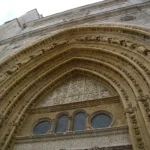Seville, the heart of Andalusia, serenades visitors with its rich cultural tapestry and architectural wonders. Among its most treasured landmarks, the Alcázar of Seville stands as a pinnacle of exquisite craftsmanship, engrossing history, and architectural evolution. This royal palace complex, boasting a blend of Mudéjar, Gothic, Renaissance, and Baroque styles, invites admirers of design and history alike. Whether your journey begins amid Seville’s vibrant streets or from afar, the Alcázar offers a captivating glimpse into centuries of artistic mastery and political power.
Table of Contents
Finding Your Way to the Alcázar of Seville
Nestled adjacent to the Seville Cathedral in the city’s historic center, the Alcázar is effortlessly accessible on foot from major landmarks. From the city center, a comfortable stroll following the bustling Calle Alemanes leads you directly to the grand entrance. If arriving by public transport, several bus lines converge nearby, while taxis frequent the area for swift access. For travelers arriving via Seville’s San Pablo Airport, a taxi ride or the EA bus line to the city center followed by a short walk proves efficient and straightforward.
Railway travelers can disembark at Seville Santa Justa station, then either take a taxi or enjoy a 30-minute walk through charming urban quarters, each step revealing layers of Seville’s urban fabric.
Architectural Transitions in the Alcázar’s Design
The Alcázar’s architectural story is a layered narrative of conquest, adaptation, and artistic brilliance. Originally founded as a Moorish fortress in the 10th century, the palace evolved significantly over centuries, reflecting successive ruling powers. The hallmark Mudéjar style dominates, characterized by intricate stucco work, horseshoe arches, and geometric tile patterns, showcasing skilled craftsmanship that harmoniously blends Islamic art with Christian influences.
Walk through the Patio de las Doncellas, and you witness proportions and symmetry that command attention. The delicate wooden ceilings, or artesonado, featuring elaborate interlacing patterns, speak to the meticulous handwork of artisans. Later Renaissance and Baroque additions introduce classical elements, creating a dialogue between styles that embodies historical transitions in southern Europe’s architectural language.
Material Craftsmanship and Artistic Flourishes
The palace’s walls tell tales beyond bricks and mortar. Stucco carvings with vegetal motifs, calligraphic inscriptions, and vibrant azulejos (ceramic tiles) narrate a story of artisans who mastered material manipulation to conjure beauty. These techniques, preserved and restored with great care, illustrate the cultural confluence that defines Seville’s heritage.
After exploring the intricate beauty of Seville’s Alcázar, you might appreciate the art and architecture collections at the Uffizi Gallery in Florence, showcasing Renaissance creativity in a historic setting.
Essence of History and Its Importance
The Alcázar is not merely an architectural marvel; it pulsates with historical significance. It served as a royal residence for Muslim, Christian, and Spanish monarchs, marking it as a theatre for pivotal moments in Iberian history. Notably, it witnessed the reign of Peter of Castile in the 14th century, whose Queen’s Chambers and garden maze mirror medieval political complexity and intrigue.
Beyond royal affairs, the Alcázar inspired literary works such as Cervantes’ Don Quixote and recently gained fame as a filming location for several international productions, further cementing its cultural footprint.
Visiting the Alcázar: Planning and Practical Advice
Entry to the Alcázar requires a ticket purchase, and given its popularity, reserving tickets online in advance is highly recommended to avoid long queues, especially during weekends and holidays. Morning visits, preferably on weekdays, offer a quieter experience enriched by soft light perfect for photography.
Guided tours unlock deeper insights into the layers of history and architectural nuances often missed by casual observers. Opting for an expert guide or audio guide enriches the visit, allowing appreciation of subtle details like the symbolism behind the tile work or the evolution of garden designs.
Remember, the Alcázar is not just an indoor site; its gardens, fountains, and courtyards require comfortable footwear and sun protection, particularly in warmer months. Photography is permitted, but tripods and flash are restricted to preserve the delicate interiors.
Reservation Details and Entry Conditions
- Tickets can be booked via the official website for seamless access.
- Entry times are staggered; punctual arrival is essential.
- Children under a certain age may enter free or at reduced rates.
- Special access and reduced fees are available for residents of Seville.
For detailed visitor information and secure reservations, consult the Alcázar of Seville official website.
Nearby Stays and Culinary Pleasures
In close proximity to the Alcázar, a variety of accommodations cater to different preferences, ranging from charming guesthouses nestled in historical buildings to modern boutique hotels offering comfort within walking distance. Staying near the Cathedral or in the Santa Cruz district immerses visitors in the atmosphere of old Seville, with winding alleys and lively plazas.
Seville’s culinary scene complements a day at the Alcázar splendidly. Traditional tapas bars and eateries serving Andalusian specialties, such as gazpacho, jamón ibérico, and freshly caught seafood, abound nearby. Don’t miss trying local delicacies at Plaza de Santa Cruz or along Calle Mateos Gago, where you can savor authentic flavors amidst vibrant street life.
If you appreciate grand royal residences, the Nymphenburg Palace’s elegant Baroque gardens and history offer a serene contrast to Seville’s vibrant legacy.
Reflections on the Alcázar’s Timeless Craft
As you meander through its ornate halls and serene gardens, the Alcázar of Seville reveals itself as a monument to the enduring dialogue between art, power, and culture. Its architectural elements invite contemplation: the balance between light and shadow, the finesse of craftsmanship, and the seamless fusion of diverse stylistic influences.
To feel Seville’s vibrant life beyond Alcázar, visit Enjoy the Rich Culture and Flavors of Seville Spain Today and taste the city’s true spirit.
Beyond being a relic of the past, the Alcázar continues to inspire awe through its capacity to capture human creativity’s finest moments. Whether drawn by its historical echoes or the elegance of its design, visitors depart enriched, carrying with them stories etched in stone, wood, and tile.

- Alcázar of Seville (7077897551) by Michal Osmenda from Brussels, Belgium on Wikimedia Commons – cc by 2.0
